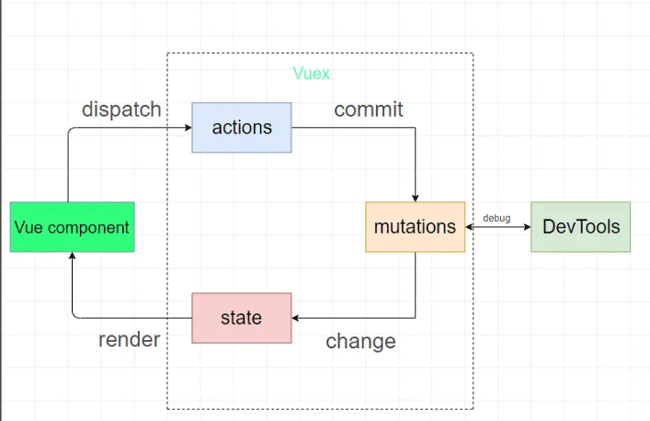您好,登錄后才能下訂單哦!
您好,登錄后才能下訂單哦!
本文小編為大家詳細介紹“Pinia、Vuex與兩個Vue狀態管理模式怎么應用”,內容詳細,步驟清晰,細節處理妥當,希望這篇“Pinia、Vuex與兩個Vue狀態管理模式怎么應用”文章能幫助大家解決疑惑,下面跟著小編的思路慢慢深入,一起來學習新知識吧。
Pinia和Vuex一樣都是是vue的全局狀態管理器。其實Pinia就是Vuex5,只不過為了尊重原作者的貢獻就沿用了這個看起來很甜的名字Pinia。
Vuex
npm i vuex -S
Pinia
npm i pinia -S
在src目錄下新建vuexStore,實際項目中你只需要建一個store目錄即可,由于我們需要兩種狀態管理器,所以需要將其分開并創建兩個store目錄
新建vuexStore/index.js
import { createStore } from 'vuex'
export default createStore({
//全局state,類似于vue種的data
state() {
return {
vuexmsg: "hello vuex",
name: "xiaoyue",
};
},
//修改state函數
mutations: {
},
//提交的mutation可以包含任意異步操作
actions: {
},
//類似于vue中的計算屬性
getters: {
},
//將store分割成模塊(module),應用較大時使用
modules: {
}
})main.js引入
import { createApp } from 'vue'
import App from './App.vue'
import store from '@/vuexStore'
createApp(App).use(store).mount('#app')App.vue測試
<template>
<div></div>
</template>
<script setup>
import { useStore } from 'vuex'
let vuexStore = useStore()
console.log(vuexStore.state.vuexmsg); //hello vuex
</script>頁面正常打印hello vuex說明我們的Vuex已經掛載成功了
main.js引入
import { createApp } from "vue";
import App from "./App.vue";
import {createPinia} from 'pinia'
const pinia = createPinia()
createApp(App).use(pinia).mount("#app");創建Store
src下新建piniaStore/storeA.js
import { defineStore } from "pinia";
export const storeA = defineStore("storeA", {
state: () => {
return {
piniaMsg: "hello pinia",
};
},
getters: {},
actions: {},
});App.vue使用
<template>
<div></div>
</template>
<script setup>
import { storeA } from '@/piniaStore/storeA'
let piniaStoreA = storeA()
console.log(piniaStoreA.piniaMsg); //hello pinia
</script>從這里我們可以看出pinia中沒有了mutations和modules,pinia不必以嵌套(通過modules引入)的方式引入模塊,因為它的每個store便是一個模塊,如storeA,storeB... 。 在我們使用Vuex的時候每次修改state的值都需要調用mutations里的修改函數(下面會說到),因為Vuex需要追蹤數據的變化,這使我們寫起來比較繁瑣。而pinia則不再需要mutations,同步異步都可在actions進行操作,至于它沒有了mutations具體是如何最終到state變化的,這里我們不過多深究,大概好像應該是通過hooks回調的形式解決。
獲取state的值從上面我們已經可以一目了然的看到了,下面讓我們看看他倆修改state的方法吧
vuex在組件中直接修改state,如App.vue
<template>
<div>{{vuexStore.state.vuexmsg}}</div>
</template>
<script setup>
import { useStore } from 'vuex'
let vuexStore = useStore()
vuexStore.state.vuexmsg = 'hello juejin'
console.log(vuexStore.state.vuexmsg)
</script>可以看出我們是可以直接在組件中修改state的而且還是響應式的,但是如果這樣做了,vuex不能夠記錄每一次state的變化記錄,影響我們的調試。當vuex開啟嚴格模式的時候,直接修改state會拋出錯誤,所以官方建議我們開啟嚴格模式,所有的state變更都在vuex內部進行,在mutations進行修改。例如vuexStore/index.js:
import { createStore } from "vuex";
export default createStore({
strict: true,
//全局state,類似于vue種的data
state: {
vuexmsg: "hello vuex",
},
//修改state函數
mutations: {
setVuexMsg(state, data) {
state.vuexmsg = data;
},
},
//提交的mutation可以包含任意異步操作
actions: {},
//類似于vue中的計算屬性
getters: {},
//將store分割成模塊(module),應用較大時使用
modules: {},
});當我們需要修改vuexmsg的時候需要提交setVuexMsg方法,如App.vue
<template>
<div>{{ vuexStore.state.vuexmsg }}</div>
</template>
<script setup>
import { useStore } from 'vuex'
let vuexStore = useStore()
vuexStore.commit('setVuexMsg', 'hello juejin')
console.log(vuexStore.state.vuexmsg) //hello juejin
</script>或者我們可以在actions中進行提交mutations修改state:
import { createStore } from "vuex";
export default createStore({
strict: true,
//全局state,類似于vue種的data
state() {
return {
vuexmsg: "hello vuex",
}
},
//修改state函數
mutations: {
setVuexMsg(state, data) {
state.vuexmsg = data;
},
},
//提交的mutation可以包含任意異步操作
actions: {
async getState({ commit }) {
//const result = await xxxx 假設這里進行了請求并拿到了返回值
commit("setVuexMsg", "hello juejin");
},
}
});組件中使用dispatch進行分發actions
<template>
<div>{{ vuexStore.state.vuexmsg }}</div>
</template>
<script setup>
import { useStore } from 'vuex'
let vuexStore = useStore()
vuexStore.dispatch('getState')
</script>一般來說,vuex中的流程是首先actions一般放異步函數,拿請求后端接口為例,當后端接口返回值的時候,actions中會提交一個mutations中的函數,然后這個函數對vuex中的狀態(state)進行一個修改,組件中再渲染這個狀態,從而實現整個數據流程都在vuex內部進行便于檢測。直接看圖,一目了然

直接修改
相比于Vuex,Pinia是可以直接修改狀態的,并且調試工具能夠記錄到每一次state的變化,如App.vue
<template>
<div>{{ piniaStoreA.piniaMsg }}</div>
</template>
<script setup>
import { storeA } from '@/piniaStore/storeA'
let piniaStoreA = storeA()
console.log(piniaStoreA.piniaMsg); //hello pinia
piniaStoreA.piniaMsg = 'hello juejin'
console.log(piniaStoreA.piniaMsg); //hello juejin
</script>$patch
使用$patch方法可以修改多個state中的值,比如我們在piniaStore/storeA.js中的state增加一個name
import { defineStore } from "pinia";
export const storeA = defineStore("storeA", {
state: () => {
return {
piniaMsg: "hello pinia",
name: "xiaoyue",
};
},
getters: {},
actions: {},
});然后我們在App.vue中進行修改這兩個state
import { storeA } from '@/piniaStore/storeA'
let piniaStoreA = storeA()
console.log(piniaStoreA.name); //xiaoyue
piniaStoreA.$patch({
piniaMsg: 'hello juejin',
name: 'daming'
})
console.log(piniaStoreA.name);//daming當然也是支持修改單個狀態的如
piniaStoreA.$patch({
name: 'daming'
})$patch還可以使用函數的方式進行修改狀態
import { storeA } from '@/piniaStore/storeA'
let piniaStoreA = storeA()
cartStore.$patch((state) => {
state.name = 'daming'
state.piniaMsg = 'hello juejin'
})在actions中進行修改
不同于Vuex的是,Pinia去掉了mutations,所以在actions中修改state就行Vuex在mutations修改state一樣。其實這也是我比較推薦的一種修改狀態的方式,就像上面說的,這樣可以實現整個數據流程都在狀態管理器內部,便于管理。
在piniaStore/storeA.js的actions添加一個修改name的函數
import { defineStore } from "pinia";
export const storeA = defineStore("storeA", {
state: () => {
return {
piniaMsg: "hello pinia",
name: "xiao yue",
};
},
actions: {
setName(data) {
this.name = data;
},
},
});組件App.vue中調用不需要再使用dispatch函數,直接調用store的方法即可
import { storeA } from '@/piniaStore/storeA'
let piniaStoreA = storeA()
piniaStoreA.setName('daming')重置state
Pinia可以使用$reset將狀態重置為初始值
import { storeA } from '@/piniaStore/storeA'
let piniaStoreA = storeA()
piniaStoreA.$reset()當我們組件中需要用到state中多個參數時,使用解構的方式取值往往是很方便的,但是傳統的ES6解構會使state失去響應式,比如組件App.vue,我們先解構取得name值,然后再去改變name值,然后看頁面是否變化
<template>
<div>{{ name }}</div>
</template>
<script setup>
import { storeA } from '@/piniaStore/storeA'
let piniaStoreA = storeA()
let { piniaMsg, name } = piniaStoreA
piniaStoreA.$patch({
name: 'daming'
})
</script>瀏覽器展示如下

我們可以發現瀏覽器并沒有更新頁面為daming
為了解決這個問題,Pinia提供了一個結構方法storeToRefs,我們將組件App.vue使用storeToRefs解構
<template>
<div>{{ name }}</div>
</template>
<script setup>
import { storeA } from '@/piniaStore/storeA'
import { storeToRefs } from 'pinia'
let piniaStoreA = storeA()
let { piniaMsg, name } = storeToRefs(piniaStoreA)
piniaStoreA.$patch({
name: 'daming'
})
</script>再看下頁面變化

我們發現頁面已經被更新成daming了
其實Vuex中的getters和Pinia中的getters用法是一致的,用于自動監聽對應state的變化,從而動態計算返回值(和vue中的計算屬性差不多),并且getters的值也具有緩存特性
我們先將piniaStore/storeA.js改為
import { defineStore } from "pinia";
export const storeA = defineStore("storeA", {
state: () => {
return {
count1: 1,
count2: 2,
};
},
getters: {
sum() {
console.log('我被調用了!')
return this.count1 + this.count2;
},
},
});然后在組件App.vue中獲取sum
<template>
<div>{{ piniaStoreA.sum }}</div>
</template>
<script setup>
import { storeA } from '@/piniaStore/storeA'
let piniaStoreA = storeA()
console.log(piniaStoreA.sum) //3
</script>讓我們來看下什么是緩存特性。首先我們在組件多次訪問sum再看下控制臺打印
import { storeA } from '@/piniaStore/storeA'
let piniaStoreA = storeA()
console.log(piniaStoreA.sum)
console.log(piniaStoreA.sum)
console.log(piniaStoreA.sum)
piniaStoreA.count1 = 2
console.log(piniaStoreA.sum)
從打印結果我們可以看出只有在首次使用用或者當我們改變sum所依賴的值的時候,getters中的sum才會被調用
Vuex中的getters使用和Pinia的使用方式類似,就不再進行過多說明,寫法如下vuexStore/index.js
import { createStore } from "vuex";
export default createStore({
strict: true,
//全局state,類似于vue種的data
state: {
count1: 1,
count2: 2,
},
//類似于vue中的計算屬性
getters: {
sum(state){
return state.count1 + state.count2
}
}
});如果項目比較大,使用單一狀態庫,項目的狀態庫就會集中到一個大對象上,顯得十分臃腫難以維護。所以Vuex就允許我們將其分割成模塊(modules),每個模塊都擁有自己state,mutations,actions...。而Pinia每個狀態庫本身就是一個模塊。
Pinia沒有modules,如果想使用多個store,直接定義多個store傳入不同的id即可,如:
import { defineStore } from "pinia";
export const storeA = defineStore("storeA", {...});
export const storeB = defineStore("storeB", {...});
export const storeC = defineStore("storeB", {...});一般來說每個module都會新建一個文件,然后再引入這個總的入口index.js中,這里為了方便就寫在了一起
import { createStore } from "vuex";
const moduleA = {
state: () => ({
count:1
}),
mutations: {
setCount(state, data) {
state.count = data;
},
},
actions: {
getuser() {
//do something
},
},
getters: { ... }
}
const moduleB = {
state: () => ({ ... }),
mutations: { ... },
actions: { ... }
}
export default createStore({
strict: true,
//全局state,類似于vue種的data
state() {
return {
vuexmsg: "hello vuex",
name: "xiaoyue",
};
},
modules: {
moduleA,
moduleB
},
});使用moduleA
import { useStore } from 'vuex'
let vuexStore = useStore()
console.log(vuexStore.state.moduleA.count) //1
vuexStore.commit('setCount', 2)
console.log(vuexStore.state.moduleA.count) //2
vuexStore.dispatch('getuser')一般我們為了防止提交一些mutation或者actions中的方法重名,modules一般會采用命名空間的方式 namespaced: true 如moduleA:
const moduleA = {
namespaced: true,
state: () => ({
count: 1,
}),
mutations: {
setCount(state, data) {
state.count = data;
},
},
actions: {
getuser() {
//do something
},
},
}此時如果我們再調用setCount或者getuser
vuexStore.commit('moduleA/setCount', 2)
vuexStore.dispatch('moduleA/getuser')讀到這里,這篇“Pinia、Vuex與兩個Vue狀態管理模式怎么應用”文章已經介紹完畢,想要掌握這篇文章的知識點還需要大家自己動手實踐使用過才能領會,如果想了解更多相關內容的文章,歡迎關注億速云行業資訊頻道。
免責聲明:本站發布的內容(圖片、視頻和文字)以原創、轉載和分享為主,文章觀點不代表本網站立場,如果涉及侵權請聯系站長郵箱:is@yisu.com進行舉報,并提供相關證據,一經查實,將立刻刪除涉嫌侵權內容。